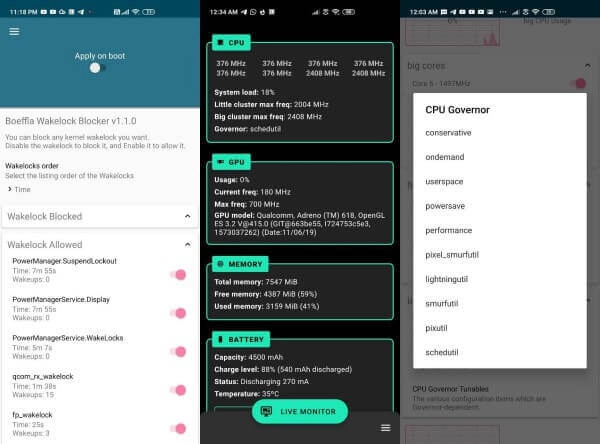Poco X2 development has just begun, and we can see several well-known developers working on the device, such as arter97. You may now get the finest Poco X2 custom kernel and flash it using a custom recovery tool. For the first time, Arter97 custom kernel for Poco X2 is released with numerous perks that may let your smartphone give exceptional performance while also preserving battery backup every day. Arter97, a well-known developer who generally releases his work on XDA-forums, created the modified kernel from scratch.
What exactly is a Custom Kernel?
A kernel is the most important component of an Android smartphone or tablet. The Kernel is in charge of the whole system, from booting to power supply. In general, a kernel that comes with a Stock ROM is reliable and engineered to function underclocked in order to extend the device’s shelf life. A custom kernel, on the other hand, is a customised version that improves the performance of the equipment and bridges the gap between the hardware and the software to give improved performance, speed, efficiency, battery life, and so on.
Advantages
There are several benefits of utilising a modified kernel in an Android device:
- A modified kernel boosts the device’s performance.
- Highly customizable
- Overclock the CPU power Developer-added features
- CPU/GPU frequency control
- The I/O scheduler is configured.
- Allow USB rapid charging.
- Change the CPU’s voltage.
Disadvantages
With all of the advantages, there is just one downside to utilising a custom kernel: it may destroy the device if not utilised appropriately. For example, if you overclock the CPU frequency and utilise it for an extended length of time, the motherboard’s shelf life may be reduced. Furthermore, using a fast charge more frequently can cause the battery to overheat, resulting in damage.
1. Arter97 Custom Kernel for Poco X2
The newest CAF MSM-4.14 has been incorporated into the arter97 Kernel for the Poco X2, and it incorporates more advanced stage updates from Qualcomm than the standard ones. It is SELinux permissive, as well as SafetyNet and Wireguard compliant. Here are some additional features:
- To replace zram, use zswap plus vbswap.
- For more efficient memory operations, we abandoned the traditional zram swap technique.
- The mainline zsmalloc memory allocator has been backported.
- Mainline zswap compressed page cache was backported.
- Samsung’s Galaxy S9 RAM upgrades have been combined for improved swapping efficiency. optimised for Android use 300 for CONFIG_HZ
- Enhanced interrupt configuration
- As the default TCP network congestion control, Sultan’s Simple LMK BBR is used.
- vDSO 32 patches for better 32-bit performance
- To increase memory allocation speed, vmalloc was backported from mainline.
- DM-verity is completely deactivated (you may correctly remount /vendor to R/W).
- Optimisation of timers
- Extra power savings are applied to the display panel RTL8152/8153 USB LAN adapter support
- Built with -O3 speed enhancements
- Built with the most recent GCC UFS optimisations
- Entropy hook on storage was removed in the most recent mainline f2fs support with GC improvements.
- The CFQ I/O scheduler has been backported from the mainline.
- Installation without a computer system
- Modules support is disabled for reduced weight. Kernel
- RTB (interrupt) logging has been completely removed.

Arter97’s Unusual Characteristics
CONFIG_HZ = 300 – This allows you to change the context switching interval from 10ms to 3.33ms. On displays with a higher refresh rate, this is a useful feature. Pixel has done this for a long time, and Google suggests that other manufacturers do the same to reduce jitter.
Optimised interrupt configuration – The standard ROM does not utilise the IRQ balancing function, but it has been enabled with the Snapdragon 730G specific setup in this modified kernel. One distinct characteristic that will aid in the balancing of our core loads and deliver improved power efficiency with less delays.
As the default TCP network congestion control, BBR is used. Google has created a new TCP congestion control that delivers the optimal result for network settings. BBR has been operating on a variety of Linux-based platforms, notably the arter97 server.
Disclaimer: The kernel has only been tested on the Poco X2, not the Redmi K30/K20. ButterflyAPK and its writers are not liable for any damages. Download Arter97 Custom Kernel for Poco X2 (Kernel Source on Github) Download Kernel Source on Github
2. Optimus Drunk Custom Kernel for Poco X2/Redmi K30
Optimus Drunk Kernel is a recent custom kernel that is well-known for its performance. Available for a limited number of Android handsets, including the Poco F1, Moto G5S Plus, and now the Poco X2 and Redmi K30. This build includes many updated and newest features that will make your smartphone the smoothest and smartest. Some features include:

- Built with the most recent GCC 10.0.4
- Lineage Kernel and Derp-based
- MIUI USB 3.0 fast charging is fully supported.
- Other kernel optimisations
- Wireguard support for AnyKernel3
- Wakelock deactivator
- Sio, Fiops, Zen, and Maple (default) Westwood TCP Schedulers of I/O
- Other kernel optimisations Download Optimus Drunk Custom Kernel for Poco X2/Redmi K30
3. Hardrock Kernel for Poco X2
The Hardrock modified Kernel for the Poco X2 may increase performance and battery backup. You may overclock or underclock the processing power of your smartphone to preserve battery life. Make sure you have Magisk installed in order to provide root access for Kernel customization using Kernel Manager. Hardrock Kernel has the following features:

- F-sync switch
- Slimbus OC audio has been adjusted (it now has full hardware audio capabilities).
- Anxiety IO Scheduler (better than Maple in terms of battery conservation)
- Latest Wakelock deactivator Boeffla
- Idler Adreno
- Awesome PIxel and EAS governors have been added, including: pixelutil, smurfutil, pixel_smurfutil, and lightning util governor.
- Kernel Upstreamed to Wireguard Support 4.14.175 Download Hardrock Custom Kernel for Poco X2/Redmi K30 (Kernel Source) Download MTweaks Kernel Manager Download Kernel Source on Github
4. HyperX Kernel for Poco X2
The HyperX kernel extends the battery life of the Poco X2 and supports USB rapid charging up to 900 mA. This Kernel is ideal for users who wish to preserve battery power throughout the day while using their phone moderately.

- Wireguard support in the first build Latest Linux 4.14.175 AnyKernel3 MIUI compatible
- Built using Clang 11 and the most recent GCC Kcal: Advanced Colour Management
- K-LAPSE: A kernel-level live display module that supports USB rapid charging (up to 900mA).
- TCP: Added TCP bar and made it the default.
- Boeffla wl_blocker has been added.
- Adrenoboost (off by default, but should be enabled and set to low for smooth operation) has been added.
- CPU-boost: scheduling rework
- Use power-saving work queues. Download HyperX Custom Kernel for Poco X2/Redmi K30 (Kernel Source) Download Kernel Source on Github
How to Install a Custom Kernel on a Poco X2
Pre-requisites
Download Franco Kernel Manager if you do not already have TWRP for Poco X2 installed. Download Franco Kernel Manager
Instructions
- Step 1: Reboot to the TWRP custom recovery menu. (Turn off your Poco X2, then press and hold the Volume Up + Power Button until you feel a vibration.)
- Step 2: Select Install and then browse to the place where you stored the Kernel.
- Step 3: Swipe to flash > from the same window, clean Dalvik/Cache.
- Step 4: Restart your computer.
Conclusion
A modified kernel for the Poco X2 will boost the device’s speed while also assisting you in balancing the battery backup. Keep in mind that this Kernel will not help you increase GPU frequencies or game performance. However, only advanced users should attempt to install it. If your Poco X2 is not running properly after installing the custom Kernel, flash the stock kernel using the custom recovery tool that was installed on your smartphone or flash the Stock ROM. You may also look into the best custom ROMs for your smartphone to improve speed and stability.










